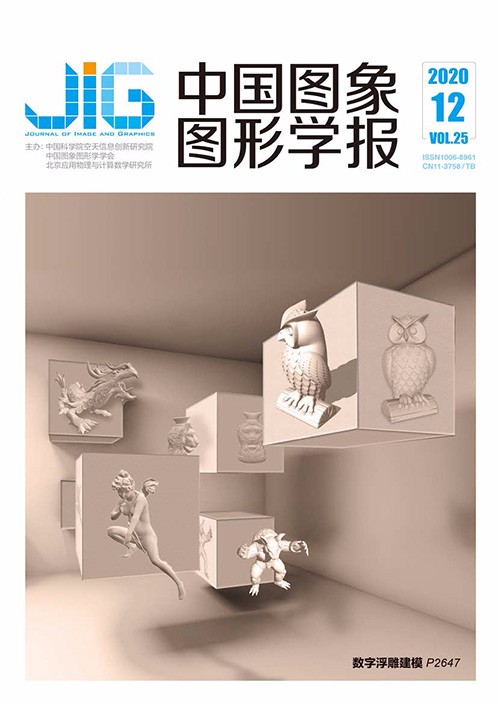
不同类型高度图控制浅浮雕模型生成方法
尚菁1, 余文杰1, 王美丽1,2,3(1.西北农林科技大学信息工程学院, 杨凌 712100;2.农业农村部农业物联网重点实验室, 杨凌 712100;3.陕西省农业信息与智能服务重点实验室, 杨凌 712100) 摘 要
目的 数字浅浮雕是在平面载体上塑造高低起伏形象的一种造型艺术,具有独特的结构及视觉效果,应用场景极为广泛。为了增加数字浮雕设计的多样性,实现浮雕的风格化应用,提出一种基于高度图的浅浮雕模型生成方法。方法 引入掩模理论,利用掩模操作对待处理的图像进行处理,融合图像处理技术,控制所要生成浮雕不同部位的高度,得到控制浮雕生成效果的高度图,借鉴已有的浅浮雕模型生成方法,利用基于高斯混合模型的滚动引导法向滤波(Gaussian mixture model based rolling guidance normal filtering,GRNF)进行法向分解,基于SfG (surface from gradients)的局部调整和全局重建的方法进行曲面重建,采用拉普拉斯算子及双边滤波器进行去噪平滑处理,最终生成不同高度风格的浅浮雕模型。结果 实验结果表明,本文方法能够生成带有不同视觉效果的浅浮雕模型,通过对细节特征及结构特征相关参数的调整,均能够生成轮廓清晰、细节丰富的浅浮雕模型。结论 本文提出的基于高度图的浅浮雕模型生成方法能够为浅浮雕的多样化设计提供新的思路和方法,在家居装饰行业中有重要的应用价值。
关键词
Bas-relief generation controlled by different height maps
Shang Jing1, Yu Wenjie1, Wang Meili1,2,3(1.College of Information Engineering, Northwest A&F University, Yangling 712100, China;2.Key Laboratory of Agricultural Internet of Things, Ministry of Agriculture and Rural Affairs, Yangling 712100, China;3.Shaanxi Key Laboratory of Agricultural Information Perception and Intelligent Service, Yangling 712100, China) Abstract
Objective Digital bas-relief is a special model that is either raised or lowered and is usually attached to a planar background. The spatial structure of a digital bas-relief lies between a 3D shape and a flat shape. Despite taking up limited space, a bas-relief contains a rich amount of details. Given its unique spatial structure and visual effects, a bas-relief can be applied across various fields. Various bas-relief models have been applied in designing ceramic vessels, wooden carvings, and coin badges, among others. Given its effective space utilization and excellent visual presentation, the bas-relief has been increasingly applied in decoration. However, with the continuous development of digital technology and 3D printing, the demand for and the requirements of bas-relief generation have become increasingly diverse. To enhance the diversity of digital bas-relief design and realize its stylized application, generating a bas-relief model based on height maps has been examined in the literature. Designing and adjusting the height map of relief works can help obtain highly efficient and intuitive embossed decorated models. Method By introducing masks and integrating image processing technology, a height map is generated to control the relief effect, and the existing bas-relief model generation method is adopted to generate bas-relief models with different styles. Masks have an important application value in the field of image processing. A mask is used to control the height of the local area and different areas of the relief to obtain different height information. Through this mask, a normal map with different height information can be obtained and used as input for the bas-relief model generation algorithm. This algorithm normalizes the vectors of different height information. Normal information processing offers two key advantages. On the one hand, transforming normal information can directly reflect surface variation characteristics, which play important roles in the later stages of geometric reconstruction. On the other hand, the depth value discontinuity caused by occlusion does not pose a problem because normal information ignores the differences in distance. In this paper, a Gaussian mixture model based rolling guidance normal filtering (GRNF) is applied in a normal decomposition operation. This model involves two steps. First, by using the rolling guide normal filtering algorithm, a rough structural side layer is decomposed from the original normal layer, and then the original normal layer and rough structure are subtracted to obtain a rough detail layer. Second, by using the expectation-maximization algorithm to solve the final parameter estimated by the Gaussian mixture model, the remaining detail and structural layers that contained tailed information can be separated in the coarse detail layer. After passing the filter based on the rolling guide, a structural layer with the overall contour feature of the relief model and a detail layer that retains the detailed feature information can be obtained. Finally, the surface of the decomposed detail and structural layers is reconstructed. Surface construction based on surface-from-gradients (SfG) local adjustment and global reconstruction is applied to transform the continuous surface reconstruction into a discrete space, and the surface reconstruction problem is effectively solved via least squares optimization. After obtaining the geometric model via surface reconstruction, some noise or interference can influence the visual effect of the bas-relief model. Laplacian smoothing and bilateral filters are then used for smoothing and denoising to obtain the final bas-relief model. Result Mask processing is used to control the height of the relief model and ensure the diversity of relief model generation. A model that references the existing bas-relief model generation algorithm shows a better generation effect. By setting the detail parameters of the adjustment model, the structural and flatness parameters of the overall relief are effectively controlled, and the bas-relief model can be used for diversification. A bas-relief model with different visual effects is eventually obtained. The experiment lists some elements, including pillows and tables, in the home decoration industry. The bas-relief models generated by masking also have unique characteristics and can be applied in decorating vases and walls. By adjusting their detail and structural features, bas-relief models can meet diverse needs, have clear outlines, and rich amounts of detail. Conclusion Height-map-based bas-relief model generation method can benefit the design of bas-relief model sand help meet the demands in home decoration. Results of this study can be combined with the existing 3D printing technology and applied in the production and processing of embossed products.
Keywords
|



 中国图象图形学报 │ 京ICP备05080539号-4 │ 本系统由
中国图象图形学报 │ 京ICP备05080539号-4 │ 本系统由